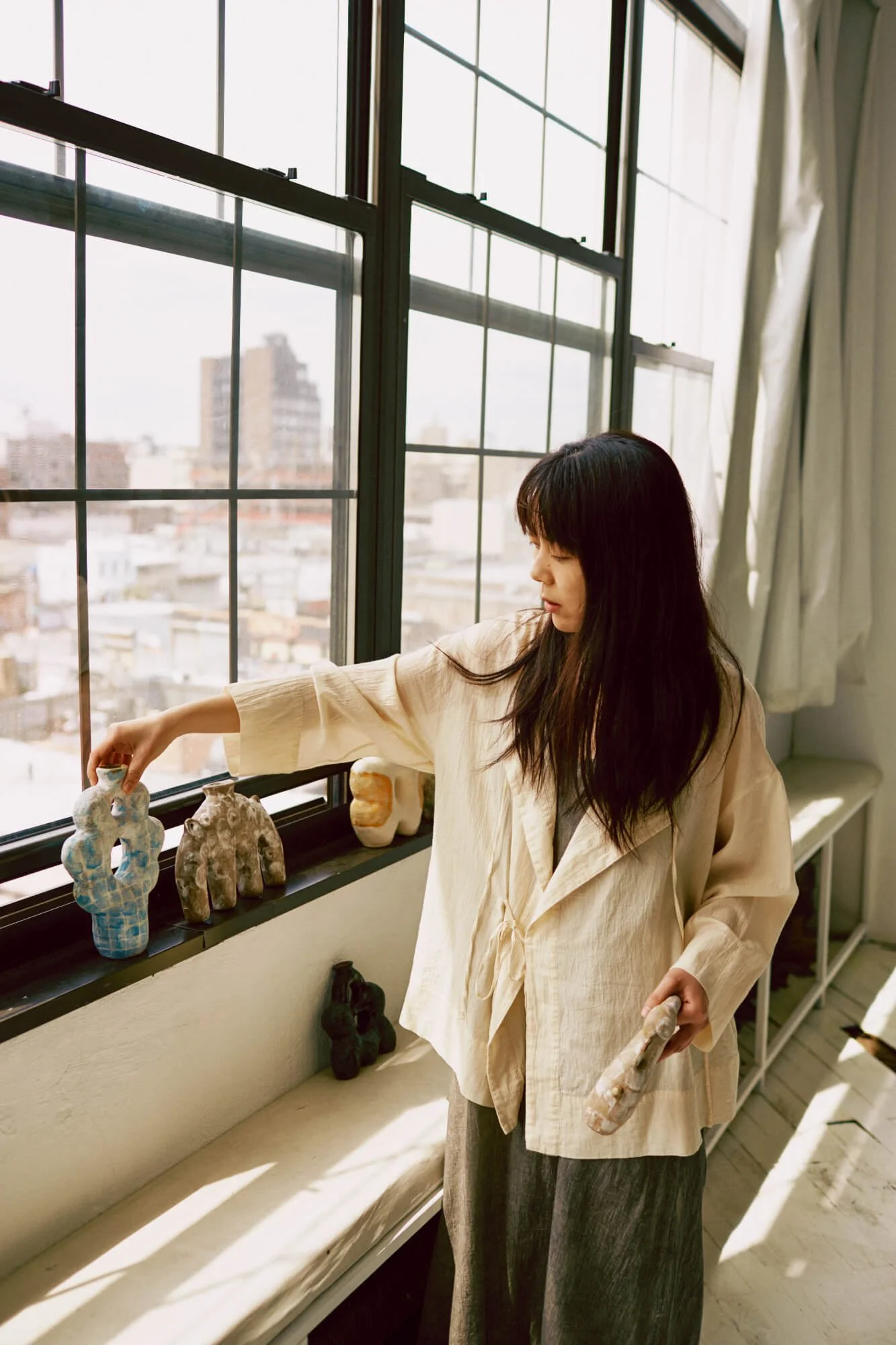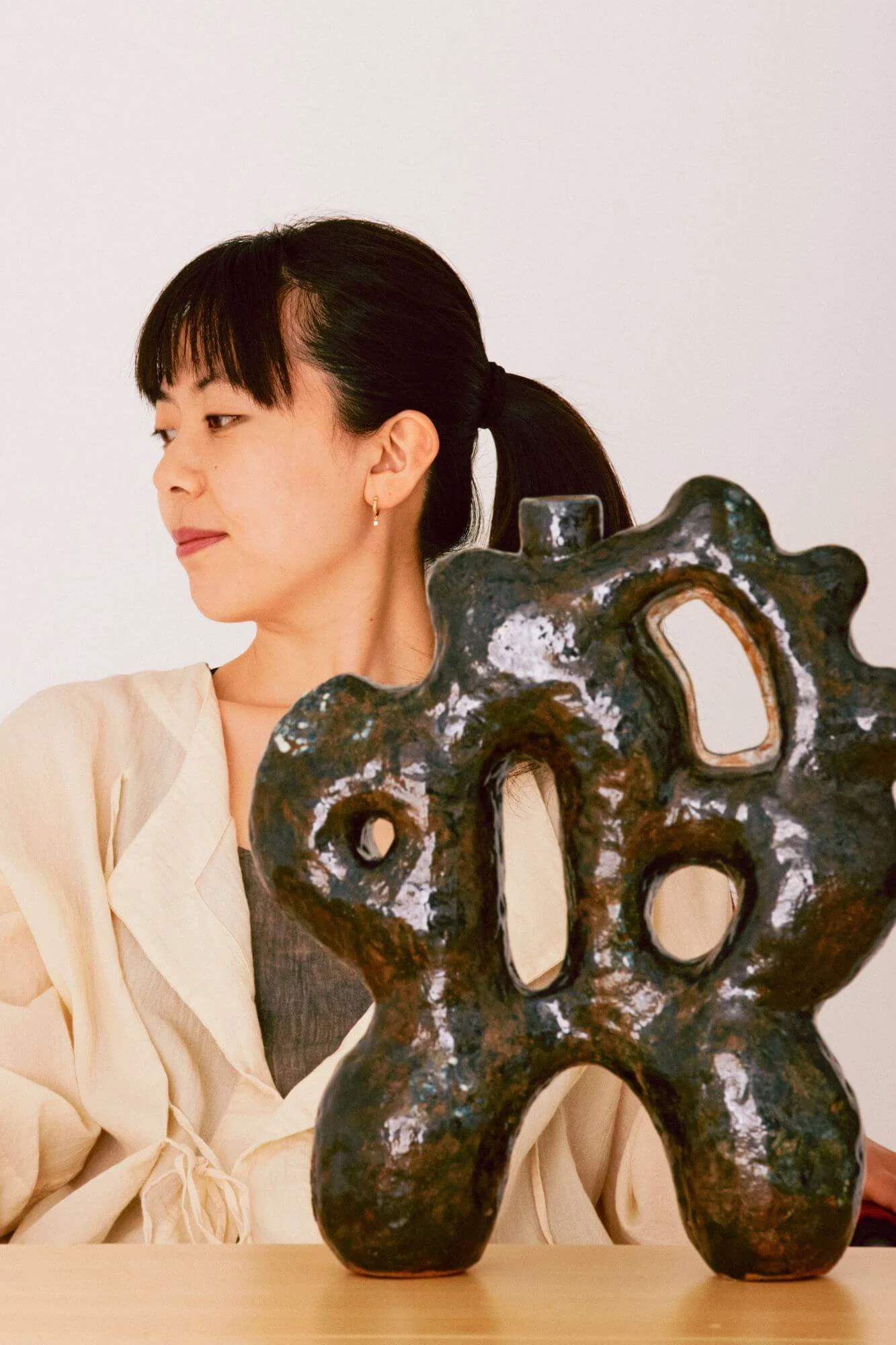Miwa Neishi
Could you share a bit about yourself and your background?
My name is Esther Lara, and I’m a visual artist and ceramicist. I was born in Murcia but soon moved to a small coastal town in Tarragona, where I grew up until my teenage years. After that, I moved to Barcelona to study illustration, as I’ve always loved drawing. Coming from a large, somewhat chaotic family, drawing became my refuge—something that has always been a constant in my life.
After finishing my studies, I shifted my focus to textile design in fashion because I was drawn to the idea of applied illustration. I liked the thought of people carrying art with them in their everyday lives, so I pursued that professionally. After 11 years in Barcelona—my second home, if not my first—I decided to seek a quieter life and recently moved to Girona. I’m now settling in, sharing a studio, and finding a sense of peace here.
What was the early motivation to express your creativity through ceramics?
I’ve always drawn and always considered myself to be more in the 2D realm. In fact, I used to think I was a bit clumsy when it came to crafts, and ceramics never really crossed my mind. But there was something about the material, something primal and ancestral, that drew me in.
At the time, I was working in fashion and started to wonder, "How could I get into this?" I'd never worked with ceramics before—hadn’t even touched it. Initially, I thought I’d just apply my illustrations to ceramics, paint on them, glaze them. But from the very first class, I was captivated by the process in a way I hadn’t expected. Drawing had always felt natural, almost like an instinct, but ceramics was a completely new discovery, and I quickly knew that this was the direction I wanted to go. And here I am, still on this path.
We know you gravitate toward different mediums, such as painting. Can you share your thoughts on how this medium has influenced your approach to ceramics?
I’m still figuring out how to merge these two worlds, painting and ceramics, without letting go of either. I believe they can blend beautifully. Painting is something I’m already very familiar with, I have an energy and technique that’s deeply ingrained. But ceramics, with its alchemical nature, has made me rethink how I paint on it. It's not as simple as transferring one skill to the other; the material changes everything, and that opens up a new path.
Ceramics, with its unpredictable processes, has allowed me to play and experiment in a way that I couldn't with drawing. In drawing, I’m more of a perfectionist, but ceramics has a certain unpredictability. No matter how skilled you are, there are parts of the process you just can’t control. That forces me to let go of expectations and immerse myself in the experience, which I find both relaxing and gratifying.
I think ceramics complements what was missing in my previous practice. It’s as if I become a different person when I work with this material. Maybe it’s because I discovered it later in life, and it frees me from preconceptions about how things "should" be done. It’s a more playful, childlike way of creating, less about ego and more about discovery.
You beautifully mentioned on your website that the process of creation allows you to build a “bridge between the physical and the spiritual, paving the way for a deeper understanding of our human nature.” Could you share more about your process and how your relationship with spirituality and mysticism nurtures your artistic practice?
It's something that's been with me for a long time, rooted in my family. Both my mother and father hold spirituality as a central part of their lives, and I grew up in that atmosphere, which sparked my own curiosity. I've always been drawn to it, particularly when it comes to dreams. It's something I've always lived with, but in recent years, I've been diving deeper into it, uncovering a more spiritual aspect to it.
There was a shift in my artistic practice when I stopped trying to control the process and instead allowed myself to draw whatever came to me, trusting that the meaning would reveal itself later. This approach liberated me creatively. I stopped worrying about repeating the same imagery, realising that if something recurred, it was important and deserved further exploration. There's a power in repetition, a message that feels more authentic and personal, and I believe it's something worth developing. For me, it's more about discovery than rationalisation. I pay close attention to recurring symbols and images, especially in my work with objects, where the symbolism or deeper connection is something I like to explore. This spiritual and mystical exploration is woven through all my work, both visually and in ceramics.
I’ve also kept a dream journal for years, filling it with sketches and reflections. Dreams have their own poetic language, one that's deeply personal, expressing something essential from within. I place a lot of value on this, believing that what appears in your dreams is important to you. While I’ve studied dream interpretation, I’ve come to see that it’s not about a universal meaning but rather a personal one. For instance, a panther might symbolise something different for me than it would for you. Some symbols are shared, but the meaning is often unique to the dreamer.
How do you interpret the impact of your surroundings—environment, culture, experiences, and social context—on the evolution of your artistic expression?
Sometimes it feels like what I’m doing is a bit outside of current trends. The world we live in now is fast-paced and increasingly virtual, which is fine, but my practice is very physical and slow, evolving gradually. For me, the value is in the process, in the experimentation, not so much the end result. The final piece is the product of trial, error, and play, and I think there’s something valuable in that.
In a way, the environment we’re in actually strengthens my approach. While everything is speeding up, I feel it’s important to hold on to this slower, more tactile way of creating, to remind ourselves of who we are. Physical connection, like touching and making with our hands, connects us to our humanity in a way that virtual or purely mental interactions cannot. It reinforces the importance of maintaining this kind of craft in a world that’s moving so fast.
Where do you think the biggest potential lies for preserving important local crafts in the contemporary context?
I think projects like yours are essential for bringing visibility to local crafts. They help add value and introduce these traditions to people who might not be familiar with the artistic environment. It’s important to make this feel more natural, more accessible—not reserved just for those who dedicate their lives to it professionally.
Workshops are a great way to preserve and share these crafts. They invite people to play, to discover something for themselves. It’s about experiencing creativity firsthand, whether it’s through ceramics, or any other craft. It’s important that everyone feels they have access to that part of themselves.
What upcoming projects are you excited about right now?
I'm currently wrapping up my second collection and feeling especially excited about delving into glazes. It's a technical area, but one that fascinates me. I believe it will unlock many new possibilities in the months ahead. I've already begun experimenting a bit, and it's amazing to witness the alchemy that unfolds—learning about the materials, not necessarily to master them, but to discover their potential. I’ve recently introduced workshops, including one on "power animals." I’ll be offering the "Tu Animal de Poder" (“Your power animal”) workshop at the end of October (26th and 27th). For me, it’s a beautiful experience because it connects to the work I’ve been doing over the past few years—creating objects with intention and viewing animals as representations of different aspects of ourselves. It’s not about rigid symbolism, but rather how an animal resonates with each person individually.
I’m also thinking about a workshop focused on amulets—smaller, personal items that carry meaning for whoever makes them. Whether it’s a necklace, a keychain, or something to hang in the car, these symbols can be a part of your daily life. It’s a project I’m passionate about, and I think it’s a beautiful way to carry something meaningful with you.
Where and how can people engage more with your work?
Primarily through Instagram and my website, but they can also visit me in Girona. @eterlarawww.estherlara.shop All images are made by Carlos Gasan @carlosgasan except the last one that belongs to Esther.



